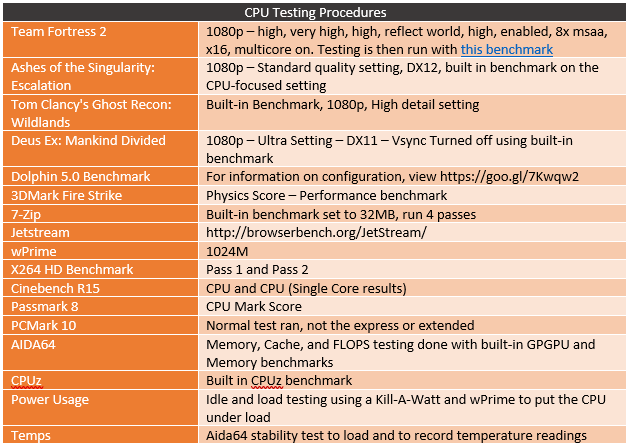Just over a year and a month ago AMD rocked the PC market with the launch of their Ryzen CPUs. They started off with their 7 series CPUs then slowly introduced the others, the Ryzen APUs only just hit the market in fact. I say it rocked the entire PC market because the Zen-based CPU launch had a cascade effect across AMD's whole lineup that drove innovation forward from just about everyone. Building high-end PCs was new and exciting. The product shortages in memory and video cards have hampered things a little but hardware wise the past year has been amazing. AMD hasn’t left things alone, now that Intel has responded AMD themselves are ready with their Zen+ CPUs. They teased them last week and today's the day you can get them. Well I’ve been busy testing them and I can finally pull the NDA shaped tape off my mouth and talk about their performance.
Product Name: AMD Ryzen 7 2700X and Ryzen 5 2600X
Review Sample Provided by: AMD
Written by: Wes Compton
Pictures by: Wes Compton
Amazon Affiliate Link: Ryzen 7 2700X and Ryzen 5 2600X
Zen+
So I think most of you know what Zen is beyond being part of the Ryzen name. It’s the architecture that makes up AMD's new CPUs. Well, Zen+ is the successor to Zen and what makes up the new 2000 series CPUs. At its core, Zen+ is a process improvement down to 12nm along with a few other changes. It's ironic actually that Intel dropped their Tick-Tock release structure and AMD basically picked things up right where they left off.
So in AMD's slide deck for this launch, there were a few interesting things. For starters, like I mentioned in our opening. The Ryzen launch has driven innovation including from Intel and AMD pointed this out showing that on the desktop side of things 4 core CPUs in the mainstream lineup has been the norm from Intel for 10 years until Ryzen launched where now Intel has 6 cores with rumors of 8. On the mobile side dual cores on thin laptops have been the norm until this year where quads are now finally being pushed into that market. They also talked about the 20 different Ryzen processors launched in 8 months and even though we didn’t cover all of those I can attest to the AMD launches making for a crazy year. Especially once you add in all of the new AM4 motherboards!
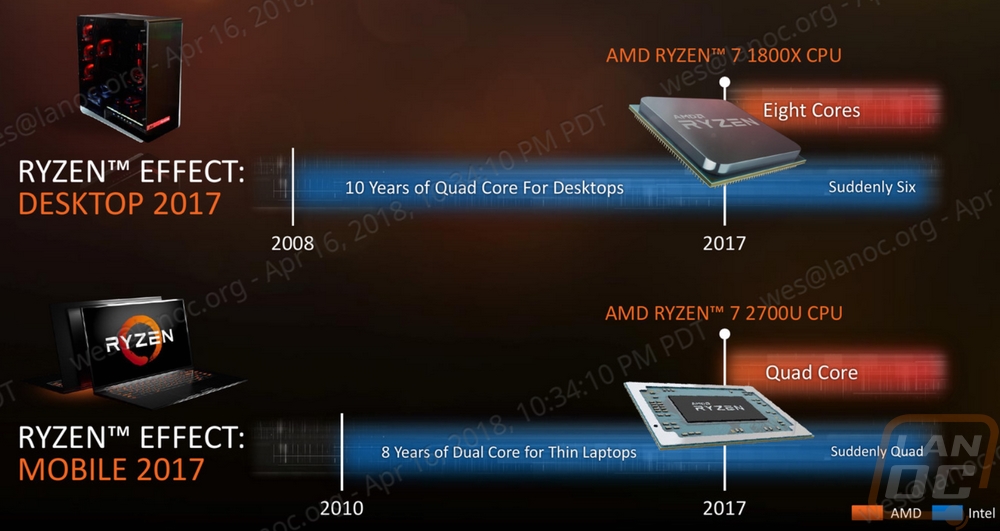

The other slide that I think people will be interested in seeing is the overall rollout plan for 2018. They show the Ryzen with Vega launches and this one. But Ryzen Pro Mobile is coming with Vega graphics, Ryzen Pro for desktop, and the second generation of Threadripper as well. It doesn’t look like 2018 is going to be any less crazy.
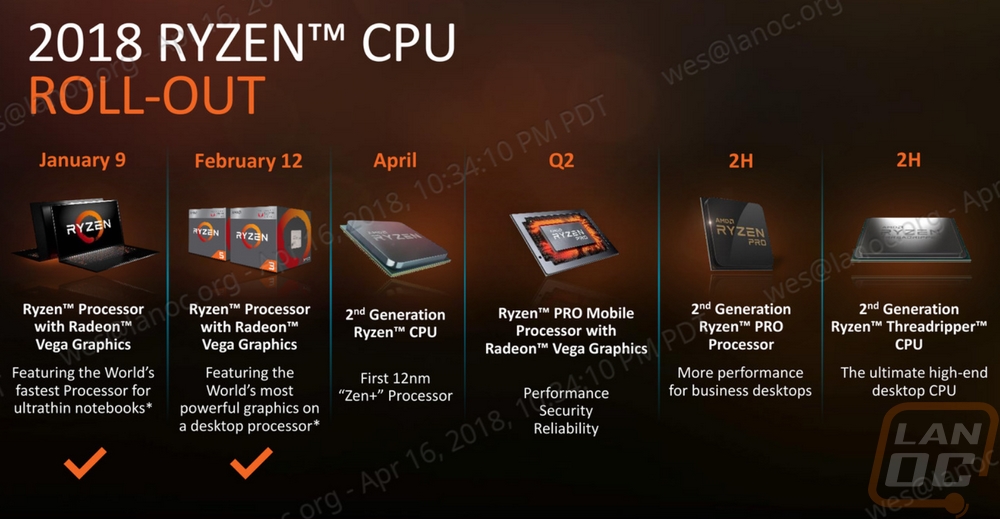
So what does the second generation of Ryzen have to offer? AMD broke things down a little. So these are the first 12nm CPUs on the market. Why is that? Well, Intel has been at 14nm and AMD was as well with the Ryzen launch. Intel decided to make their next step 10nm but has had hiccups along the way. Officially both the 14nm and 12nm shrinks are considered half-node shrinks. All together though die shrinks can lower latency by shrinking the distance between things, lower power usage and temperatures (make higher clock speeds possible), and lower costs as well. So Zen+ being on a smaller process is important, even with nothing else changed it should show improvements in all of those areas. You will notice all of those areas are touched on in AMDs deck.
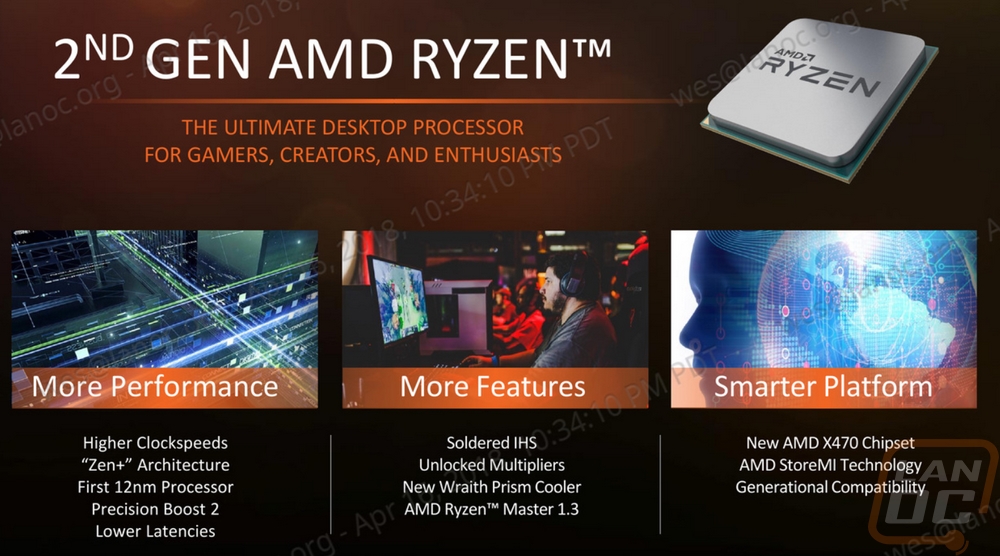
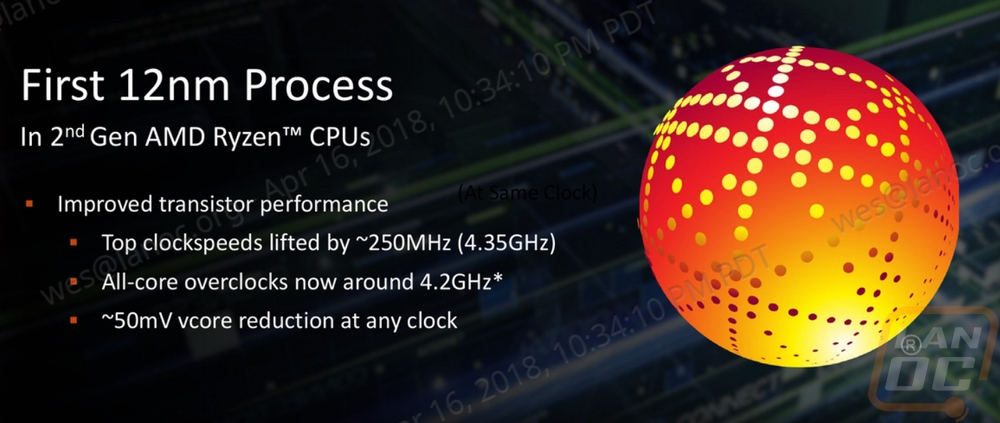
So what else is changed? Well like I said the 12nm node means lower latency and AMD is suggesting that we will see some big improvements there. This is exciting, especially on the memory because of how memory ties to the Infinity Fabric that brings all of Ryzen together. AMD is also using a new Precision Boost 2 that is part of their SenseMI tech that is going to change how boost clocks work. Before it was a 2 core or all core boost but now it is a linear scale. The graph down below shows how before there was a big drop in clock speeds when you use over 4 threads. Now it doesn’t have big drops so we should especially see better performance in that mid-range of thread usage and I’m guessing that is where a lot of everyday usage is.
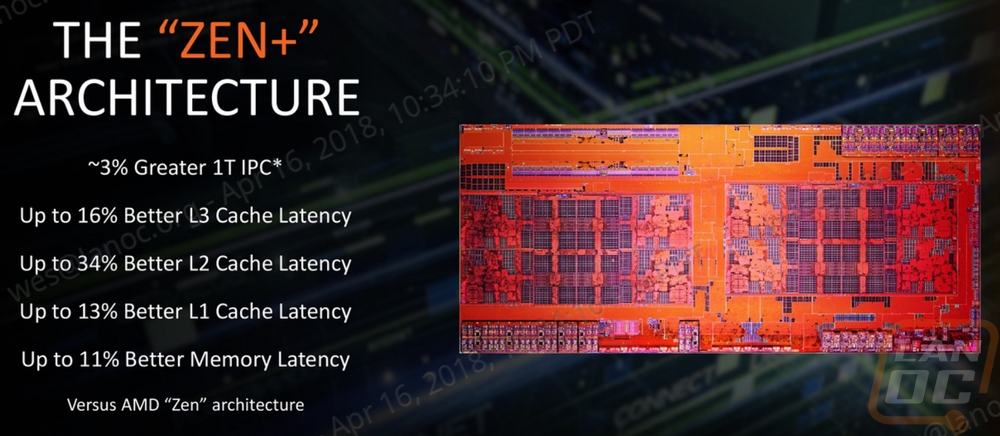
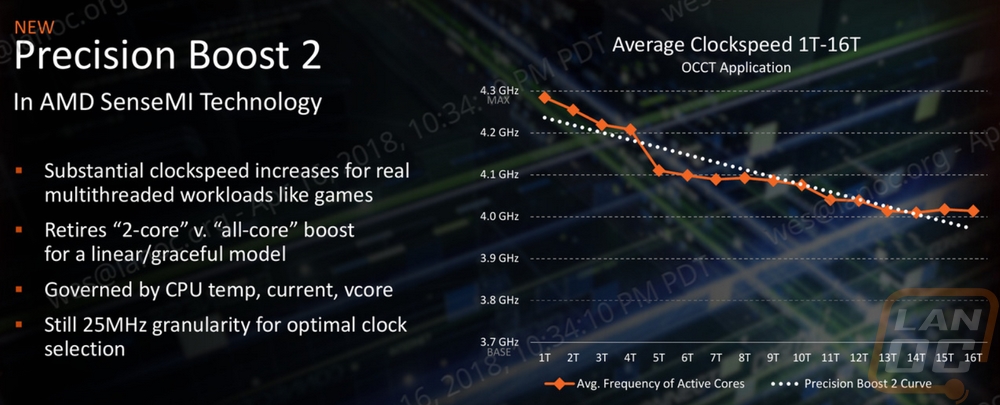
Ryzen 1700xThis slide sort of gave the impression that AMD had improved on their already good soldered heatspreader design. After confirming with them, the design hasn’t changed. What they were pointing out here is that the competition still isn’t soldering theirs. Sure it costs more, but it offers a big improvement in cooling performance. I’m happy to see that AMD is continuing this again for this generation.
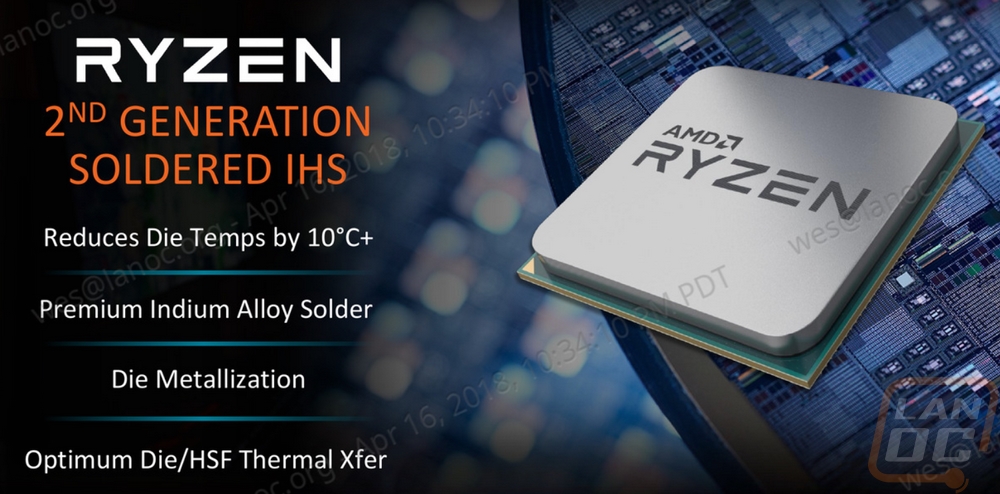
Okay, now we are finally getting down to brass tacks. These are the four second gen Ryzen, Ryzen+ or Ryzen 2000 series CPUs (whatever you want to call them) that they are introducing. These mirror a few models from the original Ryzen product lineup but you will notice that there isn’t a 1800X equivalent. So the two Ryzen 7 CPUs are the 2700X and the 2700 and they are both 8 core 16 threads just like before. The Ryzen 5 CPUs are the 2600X and 2600 with 6 core and 12 thread configurations as well. Where things are a little different is in the clock speeds. The 2700X is running at 4.3GHz/3.7GHz where the 1700X was 3.8GHz/3.4GHz and the 2700 is 4.1GHz/3.2GHz where the 1700 was 3.7GHz/3.0GHz. So the 2700X now has a base clock that is almost the same as the boost clock of the 2700X and the 2700 is .4GHz higher on the boost and .2 higher on the base clock.
For the new Ryzen 5 CPUs, the 2600X runs at 4.2GHz/3.6GHz coming from 3.6GHz/3.2GHz, that’s a big jump on the boost clocks! The 2600 is now at 3.9GHz/3.4GHz where the 1600 was 3.6GHz/3.2GHz, not as big of a jump but a jump none the less. Even better the launch pricing is much lower as well for all four models. The 2700X is now $329 where the 1700X was $399 for example and that 2600 is actually under $200!
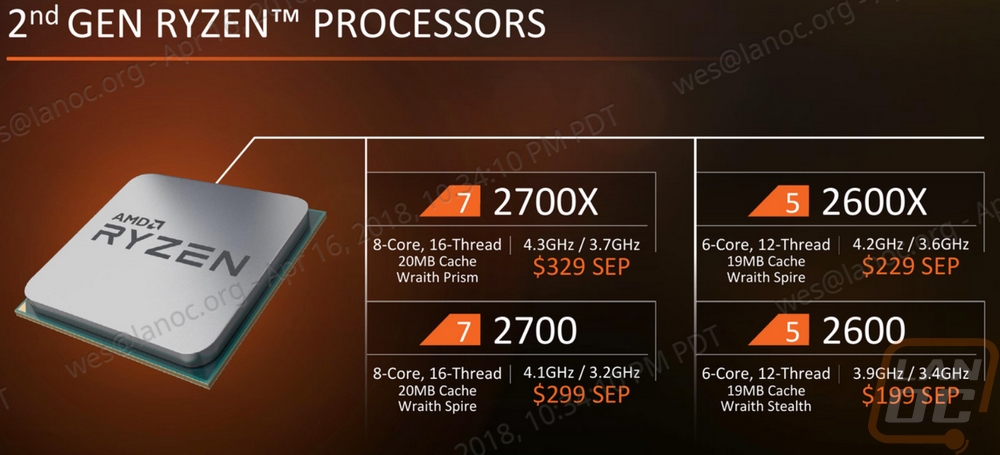
The current product stack is a little different. The 2700X takes over for both the 1700X and 1800X, the other new CPUs replace the gen 1 models. But the 1500X and 1300X still slip through. The Raven Ridge CPUs are also replacing the 1400 and 1200.
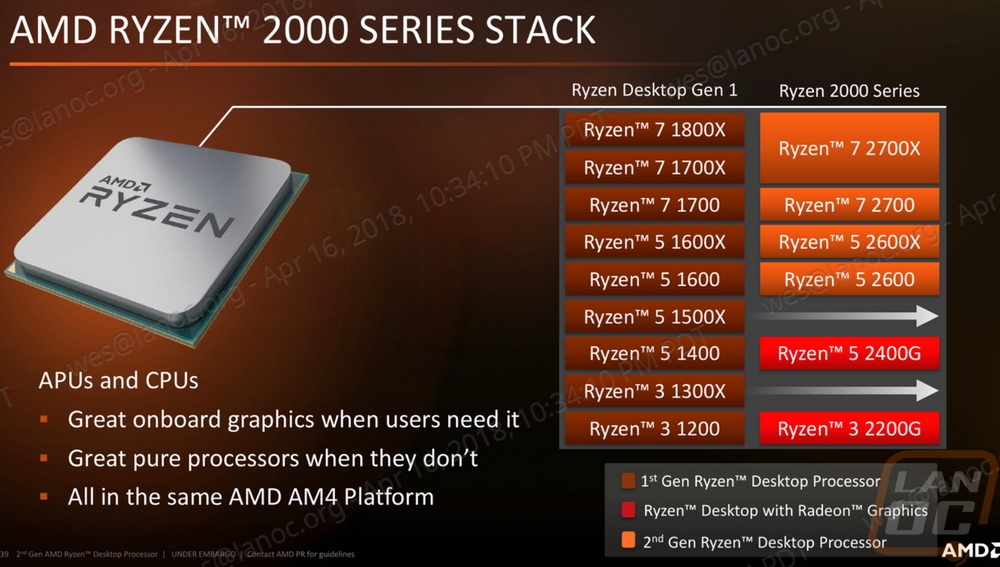
In addition to lowering the prices, the flagship CPU the 2700X now also gets a new heatsink where before the 1800X and 1700X didn’t include a cooler at all. Given how popular the Wraith coolers have been I think most buyers will be happy about the change. Not to mention they have brought out a new cooler called the Wraith Prism. The picture below makes it look like the original Wraith only with independently controlled RGB lighting for the ring, fan, and logo but they changed more than that. They have better memory compatibility now because the cooler is higher, the extra height should also translate to better cooling as well. They also have changed to a direct contact heatpipe design to help with the cooling as well.
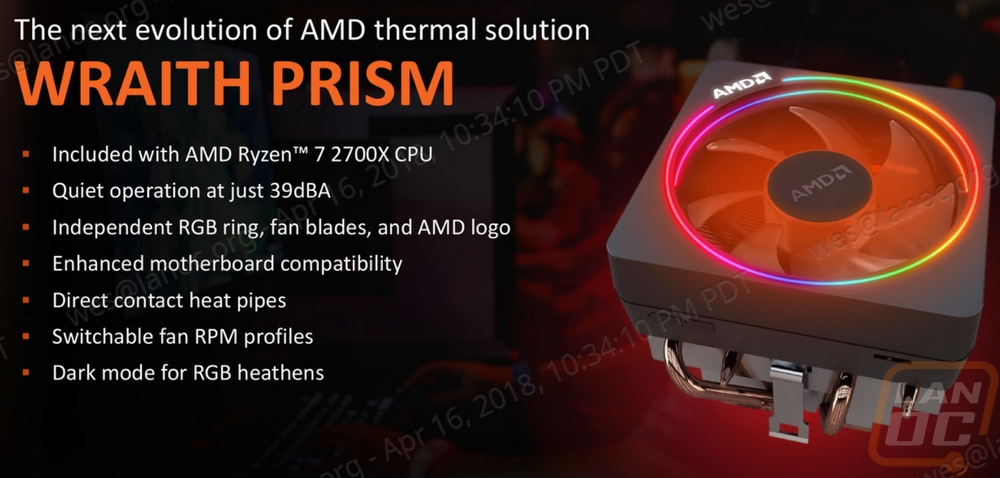
With the new CPUs, AMD is also introducing the new X470 chipset as well. As you can tell from the slide this isn’t a big change from X370 at all. There are some improvements in power delivery to help handle the improved boost clocks and beyond that it's just an excuse for everyone to bring out new designs. As long as X370 owners aren’t upgrading for no reason I’m okay with the small update. New motherboards is a big improvement from AMD boards pre-Ryzen where you basically get a few boards for years with no updated versions for new technology.
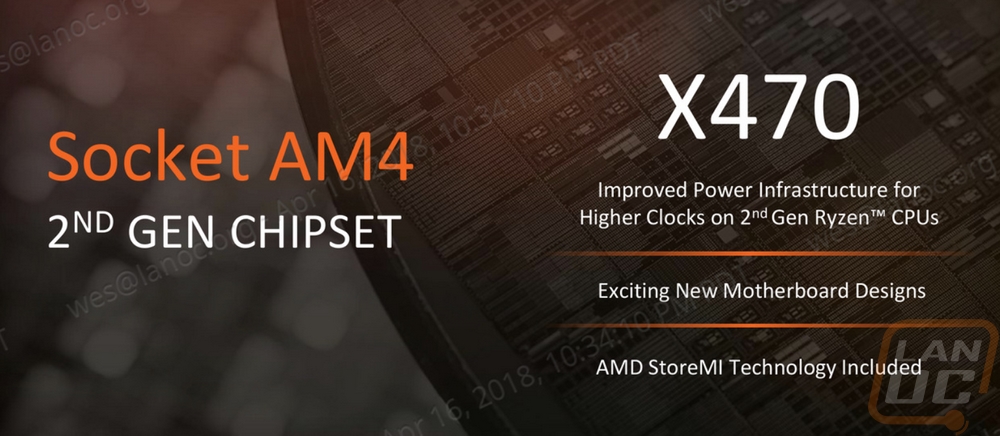
Whats In the box
Well with a new AMD launch comes yet another awesome box of AMD goodies. Full disclosure, AMD sent all of this over for testing Ryzen 2000 Series. So this time there isn’t a nice wooden box like the original Ryzen launch but they did include another black Ryzen box along with a second smaller one. I must admit when I first saw Lisa Su post up pictures of the grey Ryzen box I thought maybe they were doing a water cooler bundle again. Anyhow inside of the black box were the two motherboards, the memory, and a cover that says to Bring Your Imagination To Life.


Our kit came with the MSI X470 Gaming M7 AC and the X470 Aorus Gaming 7 Wifi, I will be diving into each of those individually as well as an Asus board that Asus sent over one at a time.

They partnered with G.Skill again and this time they sent over a set of Sniper X memory. This is a Ryzen compatible kit obviously and it is unique with its urban camo design on the top of the heatspreaders. It’s a 16 GB kit and they run at 3400MHz with 16-16-16-36 timings. This is an improvement over the kits in the past and I tested both the new Ryzen 2000 Series CPUs as well as all of our original Ryzen CPUs with this new kit.




So that wide grey Ryzen box, well that is what they packed the two CPUs in. They sent both CPUs in retail boxes with their respective coolers. Right on top when I opened everything up they also had a paper about the new Wraith Prism cooler. Don’t worry AMD I’ll get to it.





So here are the two coolers. The 2600X comes with the normal Spire cooler, not the one with RGB lighting. Then the Wraith Prism is to the right. You can see that it is a little taller than the previous design. I’m planning on a short article comparing the Prism to the original Wraith soon. In fact, as I write this I’ve already finished the testing. I just want to spend a little more time talking about it than this article will really allow.



So here are the two CPUs. There isn’t much to note here unless you have never seen an AMD CPU before. Unlike Intel, AMD has stuck with a pins on the CPU design. There are pro’s and cons, for example, these pins are stronger and a little harder to damage but the design doesn’t grip as well so you are a lot more likely to pull the CPU out when pulling a heatsink off. Anyhow they still have the AMD Ryzen logo etched into the heatspreader. Our 2600X was etched up higher, I’ve never seen that happen before. Beyond that, I should just note that it was clear that these had been tested prior to being shipped to me. There is no way to know if there was any cherry picking or anything, but I did see a fingerprint in thermal paste and extra paste around the edges. This isn’t unusual for pre-launch CPUs. A lot of times they update microcode on samples up until the last minute, not to mention with a set launch you don’t want to send out a dead CPU.




Test Rig and Procedures
Test System
Motherboard: MSI X470 Gaming M7 AC- Live Pricing
Cooling: Noctua NH-U12S for cooling - Live Pricing
Noctua NT-H1 Thermal Paste - Live Pricing
Memory: G-Skill Sniper 3400MHz CL16-16-16-36 8GB - Live Pricing
Storage: Kingston HyperX 240GB SSD - Live Pricing
Video Card: Nvidia GTX 1080 Ti - Live Pricing
Power Supply: Corsair TX750M - Live Pricing
Case: Dimastech Test Bench - Live Pricing
OS: Windows 10 Pro 64-bit - Live Pricing
CPU Performance
Well, what we are all here for it to see just how well the new Ryzen 2000 Series CPUs perform right? Well before jumping into that I want to touch a little more on my testing, beyond what you can find in the previous section. In addition to testing just the two CPUs that AMD sent. I did a LOT of retesting as well because of meltdown and spectra, I wanted to be sure I had good comparison numbers. I retested the 8700K and 8400 and all of the original Ryzen CPUs except the 1700 that sadly I had trouble with and couldn’t complete the retests. The AMD CPUs were tested with the provided (3400MHz) memory and Intel was tested with our normal memory so there is a performance difference there so please keep that in mind.
Anyhow for our first test, I jumped into X264 HD Benchmark. This tests the FPS when video encoding so higher is better here. So the 2700X still hasn’t caught up to Intel’s high-end high core count CPUs or the 8700K and 7700K but it is highly improved over the Ryzen 1 CPUs. Both the 2600X and 2700X outperformed ALL of the other Ryzen CPUs but 40 FPS or more.

Next, I went with my favorite benchmark. I like Cinebench because I can test both with a single core and with all of the cores to get a good look at the performance you can expect with old single-threaded software and new multi-threaded programs. In the Multi-Core test the 2700X topped the AMD CPUs and even came in a little above the 6900K but the higher core count Skylake-X CPUs still came out on top. It's important to note here that the 8700K and the 2600X were going blow for blow in that test as well. Now in the single core test, the Intel mainstream lineup is still at the top by a large margin. The improvements from the Ryzen 1 to Ryzen 2000 Series CPUs is big though, from in the mid to high 150’s to low 170’s. That is a big jump in a year.


Now, this was a new test that I added because I noticed a lot of people have been posting up CPUz benchmarks recently. As a bonus, it also does the same multi-threaded and single-threaded tests that I love Cinebench for. So you can see all of the CPUs I retested here. The 2700X dominated the multi-threaded test, of course, I haven’t put the high core count Intel’s through it yet either. But I like seeing it being up above the 1800X by a good amount. The 2600X and 8700K are once again trading blows and were within just 8 points of each other. Once again the 8700K was at the top of the single thread chart and I didn’t get to retest the 7700K to see if it would be as well. But the two Ryzen 2000 Series CPUs are up above everything else.


Next, I got into math based benchmarks like wPrime and 7-Zip. In wPrime the lower the number the better and as you can see the 2700X did really well, with the 7900X about 10 seconds faster and being tied with the 7820X. Given the price tag on that 8 core CPU, I would consider that a win. The 2600X came in 8 seconds behind the 8700K and 10 faster than the 1600X. The 2700X is still the star of the show here with its 2 extra cores but the 2600X is holding its own. In 7-Zip it was more of the same. The 8700K was faster than the 2600X, by a larger margin this time. Then the 2700X was behind that $500 7820X.


So Jetstream is a benchmark I’ve been toying around with for a while. This is a Java/HTML5 test that runs through a whole list of standard tests in a browser. It averages out the score then does it all over again two more times to average out the score again. This shows what you can expect for normal browser performance, aka what most people do the most on their computers. The funny thing about this test though is sometimes you get results that don’t make a lot of sense but are repeatable. The testing is solid, but its clear that high core counts don’t always help with day to day performance. The Intel CPUs as a whole dominate this test with the 4 core models up top and the high dollar high core count CPUs at the bottom but still above all of the Ryzen CPUs. The same happens in the Ryzen CPUs as well. The 2700X did really well here, but notice that 1300X randomly up near it.

Next, I get into Passmarks Performance Test 9. Rather than have our GPU or storage effect the results I run just the CPU tests to get an overall CPU score. Here the higher core counts help as you can see the 2700X is up just below all of Intel’s Skylake-X CPUs. The 8700K is below the 2700X but well above the 2600X due to its higher individual core speeds.

Next, we have PCMark 10, I like this test because while technically a synthetic benchmark they have a lot of real world based tests in it. They run browser and video tests like you would use a PC every day. Test image editing, word processing, and excel. Then they toss in a few gaming tests as well. It is basically exactly what I do every day. So how did Ryzen 2000 Series do? Well, the 8700K and 7700K are still at the top, as are all of the Skylake-X CPUs. But the 2700X did improve over the previous 1800X performance. It is right in between to of the most unlikely of CPUs, the 8400 and the 7980XE, Intel’s current most expensive and one of their cheapest as well. The 2600X was down a few more.

Now I can finally start to get a look at potential gaming performance with 3dMark and Dolphin 5.0. Dolphin is a Gamecube and Wii emulator and emulators are very CPU dependent. Here a lower score is better because these are the number of seconds it took to complete the benchmark. So both the 2600X and 2700X are right in the middle of the pack. Again the high-end mainstream and high-end Skylake-X CPUs dominate. The 2700X came in behind the 6900K, but the gap between them was significant. There was the i5-7640K than the 2600X behind that. The two Ryzen 2000 Series CPUs are well ahead of all of the older Ryzen CPUs though. Then in 3DMark, I used the base Fire Strike focusing on the CPU specific Physics Score and here the 2700X is up closer to the top with the 2600X near the middle. The 2600X was behind the 8700K and the 2700X was up in the mix with all of the high core count Intel Skylake-X’s.


Okay finally, we can see how things have improved in gaming. Ryzen, when it launched, struggled when gaming. AMD did a good job of getting some improvements with windows updates and working with some of the game manufactures. But remember all of our Ryzen results other than the 1700 are retested with these improvements and with faster memory. You can see how the 1700 is back behind in all four games I tested in. But what about the 2600X and 2700X? Well in Ashes of the Singularity the 2700X did really well, outperforming the 7700K even and between the Intel patches and Ryzen improvements the 8700K and 2700X were 3 FPS apart. The 2600X, however, was farther down. In Wildlands the numbers are even better, the two Ryzen 2000 Series CPUs are up just below the two new Intel CPUs at the top. Going old school in TF2 the 2600X and 2700X are right in the middle. TF2 is very CPU dependent but not as good with multi-threading so good individual core performance is more important here. Then last but not least is Deus Ex, once again the Ryzen 2000 Series CPUs are right in the middle. Here the Intel CPUs are all bunched up at the top and the Ryzen CPUs are down at the bottom but the gap between them all isn’t very large save for the R3 1200/R3 2200G. So what’s the verdict on gaming? Well its going to take a LOT more tests than what is in our CPU test suite, but it looks like Ryzen is slowly making up the difference. AMD hasn’t caught up yet, at least in our tests, but I like seeing the 2700X and 2600X up in the top half of the charts.




For my last round of test, I ran a few tests in AIDA64. I like to check out the cache and memory performance and just for fun, I include single and double precision and IOPS tests. What I wanted to see here was if there really was an improvement in the L1, L2, and L3 cache like AMD suggested in their press deck. Specifically in latency and there was. The L3 latency especially is actually faster on these two Ryzen 2000 Series CPUs than anything else tested. Memory speeds improved and are now much higher than the 8700K (with slower memory). L1 cache speeds on Intel are still in a different class, but Ryzen 2000 Series kept up or bested Intel in all of the other tests. As for single and double precision, the 2700X is faster than any of the other Ryzen CPUs but Intel is still way ahead there as well, same in Integer IOPS.
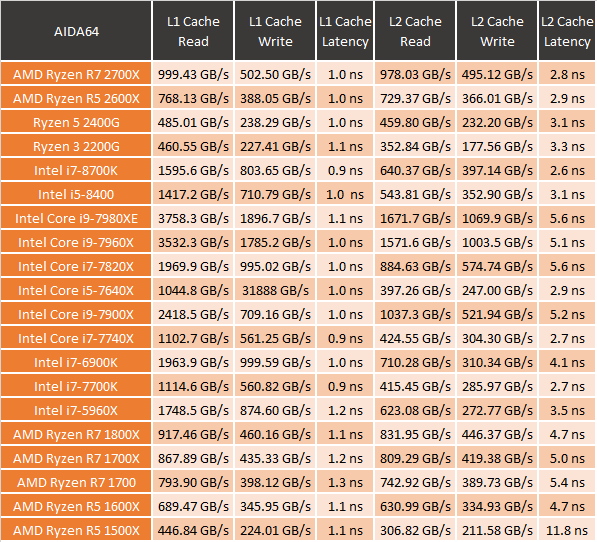

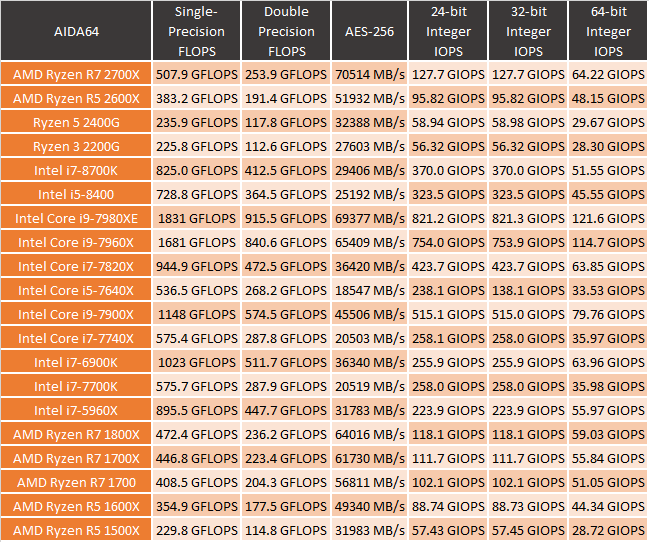
Power Usage and Temperatures
For the last portion of my testing I like to take a look at the less popular areas, power usage and temperatures. For power usage, I test both idle and load wattage draw using a kill-a-watt. This means these numbers include the entire system. To put things under load I have two different tests and because of that two different graphs. I use wPrime but recently have been also testing using the AIDA64 stress test with the FPU setting. So with the wPrime test, the 2700X was up near the top portion of our charts with 175 watts pulled total and 153 for the 2600X. For comparison, the 1700X pulled 152 and the 1600X 139 watts. It's clear that Ryzen 2000 Series while improved is pulling more to push those new higher boost speeds. Interestingly enough when retesting the 8700K and 8400 from Intel their numbers in both tests dropped considerably from my original launch tests. This might be a side effect of the slightly lower performance from the Meltdown patches or Intel has done some major improvements in their micro-code and drivers in the last few months. Either way in the wPrime test it was down, much lower than almost all of the Ryzen CPUs. Don’t worry though, Intel was also up at the top leading the charge with their Skylake-X CPUs to pull the most.

Now the AID64 stress test pulls more wattage, that is why I’ve been moving to it. I’m looking to get a worst case number when possible so here the 2700X pulls 192, 17 more than in wPrime and the 2600X pulled 171. This was much higher than both of the Coffee Lake CPUs. In fact, the two Intel CPUs together pulled less than the 2700X, even after retesting I still have a hard time believing those results honestly.

Surprisingly enough though with that 12nm node the two Ryzen 2000 Series CPUs did really well in the temperature testing. This was done in AIDA64 as well with the same stress test as the power. I tested using a Noctua U12S. Don’t worry I also tested with the Wraith Prism as well but I’ll talk about that another time. Using the same cooler as the rest of the CPUs the 2700X and 2600X were down near the bottom of the charts at 54 and 48 degrees. For reference, the 8700K was up at the top with the 7700K just to compare the efficiency. It looks like sticking with solder for the HIS was a good call ?.

Overall and Final Verdict
Well after a week and a half of testing, retesting old CPUs, testing motherboard, photos, videos, editing, and of course writing here we are. Now that I’ve had some time to live with the Ryzen 2000 Series CPUs I first have to say that AMD continues to improve on what they put together for last year. Both the 2700X and 2600X that they sent me to test are solid performing CPUs. The 2700X in almost every case and the 2600X in most tests outperforms every single Ryzen CPU launched last year and managed to do it will running cooler. For the most part in the non-gaming tests, the 2700X actually sticks close to the $469 8 core Intel i7-7820X and in a shocking number of tests the 2600X is right with the 8700K. The efficiency improvements that the 12nm process improvement brings helped lower cache and memory latency and I think most of you know just how important memory performance is for Ryzen CPUs. Add to that the new more linear boost clocks and overall higher clock speeds and it all helps these two CPUs perform well in all of the tests.
The temperature testing really blew me away with the 2700X and 2600X both being near the bottom of the charts, even with higher clock speeds. The die shrink helped, but sticking with a soldered heatspreader also plays a big role here when compared to the Intel i7-8700K and i5-8400. The new cooler included with the 2700X is also really amazing. I plan on taking a closer look at it in the upcoming weeks, but let's just say it performs really well and that RGB lighting on top looks great. Adding a cooler was a big value adder overall, but this one specifically is going to be sought after by AMD fans for sure.
Now the power draw on both CPUs was a little high, even when ignoring the weird Coffee Lake results I had in my retests. But they weren’t anything I would be overly concerned about, especially with the CPUs still running cool. The gaming performance was also another concern going into this. I know I listed it as a con in the images down below, but I had originally planned on having it as a pro as well. AMD has made big improvements in gaming performance from the original Ryzen launch until now. Add to that the new CPUs are noticeably faster in game than the first gen Ryzen CPUs. But even with those improvements, in two of the four games I tested, I would have liked to see better performance. Last years Intel i5 was running with the 2700X in TF2… This was only a four game test, hopefully, I will be able to do most tests post launch like we did with the 1700 vs the 7700K last year. That said performance was still more than worth it when considering the performance in all of the other benchmarks.
So should you be jumping on the Ryzen 2000 Series ship? Well, it looks like AMD is going to continue to get more and more competitive in pricing. Last years Ryzen pricing that wowed everyone at the time looks expensive when compared to the pricing of the four new CPUs now. I know a lot of people are going to be eyeing the 2700 over the 2700X but I will say if you plan on air cooling for a while the 2700X will be worth stepping up too just for the improved cooler. The Wraith Prism should hold most people over until they jump to a large air cooler or water cooling, it even has enough headroom to overclock on it. But for me the R5 2600 is looking like a sweet deal, imagine that CPU paired up with one of last years B350 motherboards. You can find a few great B350 boards for less than $80, you could toss a case in with those and still only cost you what the Intel 8700K does. Hell 16 gigs of memory is nearly going to cost as much as this 6 core CPU with a cooler.
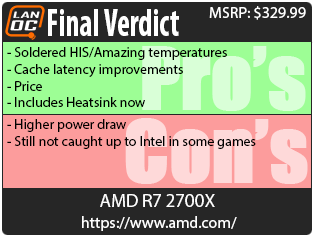

Live Pricing: HERE
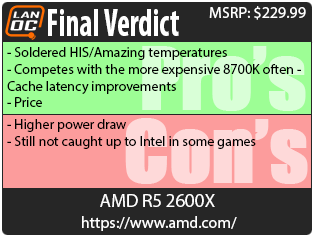

Live Pricing: HERE


